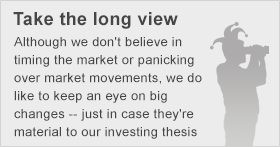
After a banner year in 2013, this year has been less remarkable for the Dow Jones Industrial Average (^DJI 0.55%) and the stock market in general. Last year's market was driven by multiple expansion, not earnings growth, and earnings now are just trying to catch up to expectations. That has resulted in a reversal for some of last year's best stocks as investors move into safer names with more stable earnings.
The stocks leading the Dow in 2014
Caterpillar's (CAT +0.15%) near-16% stock rise in 2014 is less of an endorsement of this year's results than it is relief that the heavy-equipment maker's performance isn't even worse. Sales of mining equipment is expected to be down roughly 80% from its peak in 2012, and only demand for construction equipment could overcome that drop. Full-year demand for construction equipment is expected to grow about 10%, up from a previous estimate of 5%, and the profit outlook has already been increased a quarter to $5.55 per share. Caterpillar will have to begin growing to justify an even higher valuation, but so far this year even a small increase in profit has investors giddy.

Construction equipment sales will have to keep Caterpillar afloat this year.
Merck (MRK +1.35%) and Johnson & Johnson (JNJ +2.09%) have respectively returned 14.4% and 11.8% to investors this year, in large part because more Americans have health insurance than a year ago. The number of uninsured Americans has dropped from 17.1% to 15.6%, driven by over 8 million people signing up for insurance on health-care exchanges under the Affordable Care Act.
The more people who are insured, the larger pool of potential customers for the drugs, medical devices, and consumer goods that Merck and Johnson & Johnson produce. The moves certainly aren't driven by outstanding earnings, as Merck's revenue was down 4% in the first quarter and Johnson & Johnson's was only up 3.5%.
The other factor helping medical-focused companies this year is a broad move away from risk toward companies with more stable earnings. Medical sales aren't growing rapidly, but they also represent a necessary expenditure. With the American population getting older, the business is among the more stable on the market.
